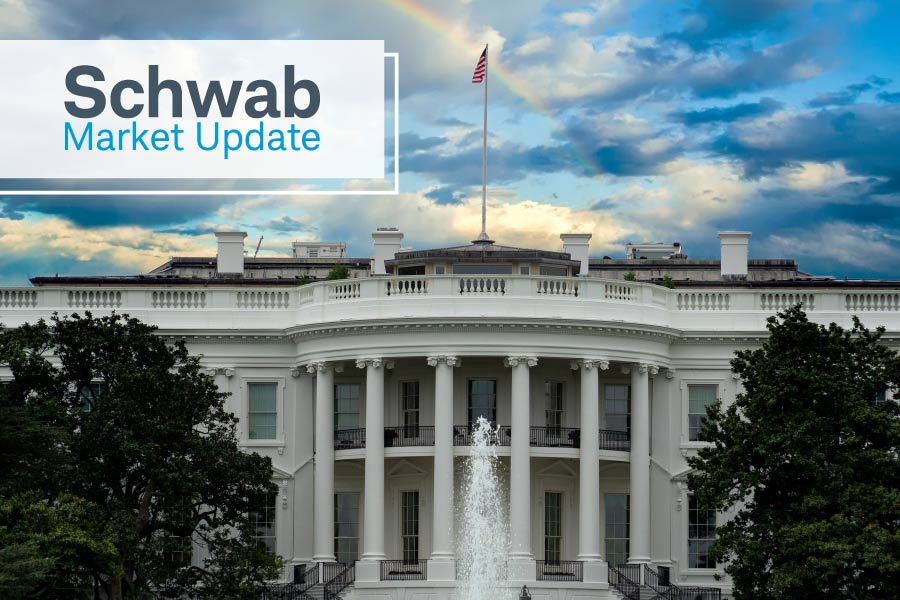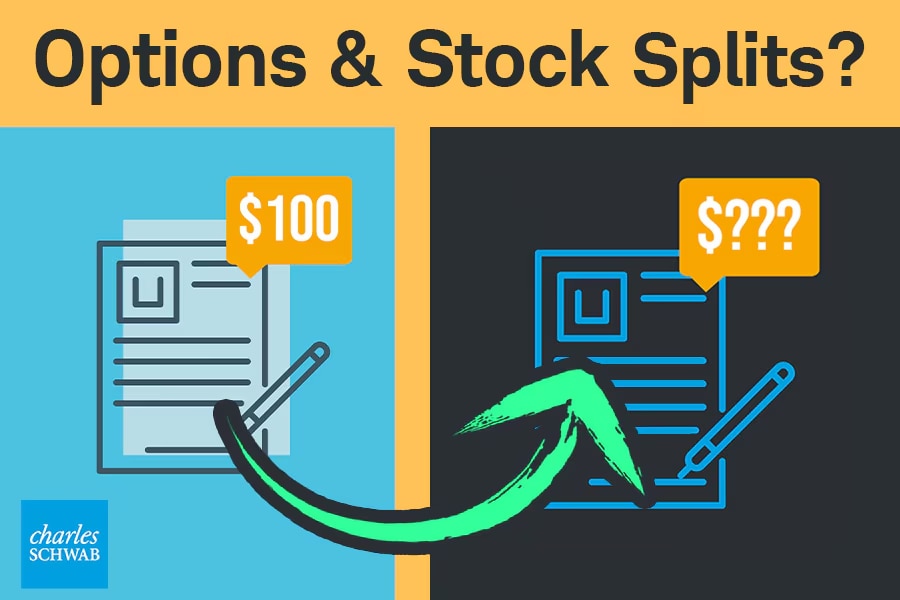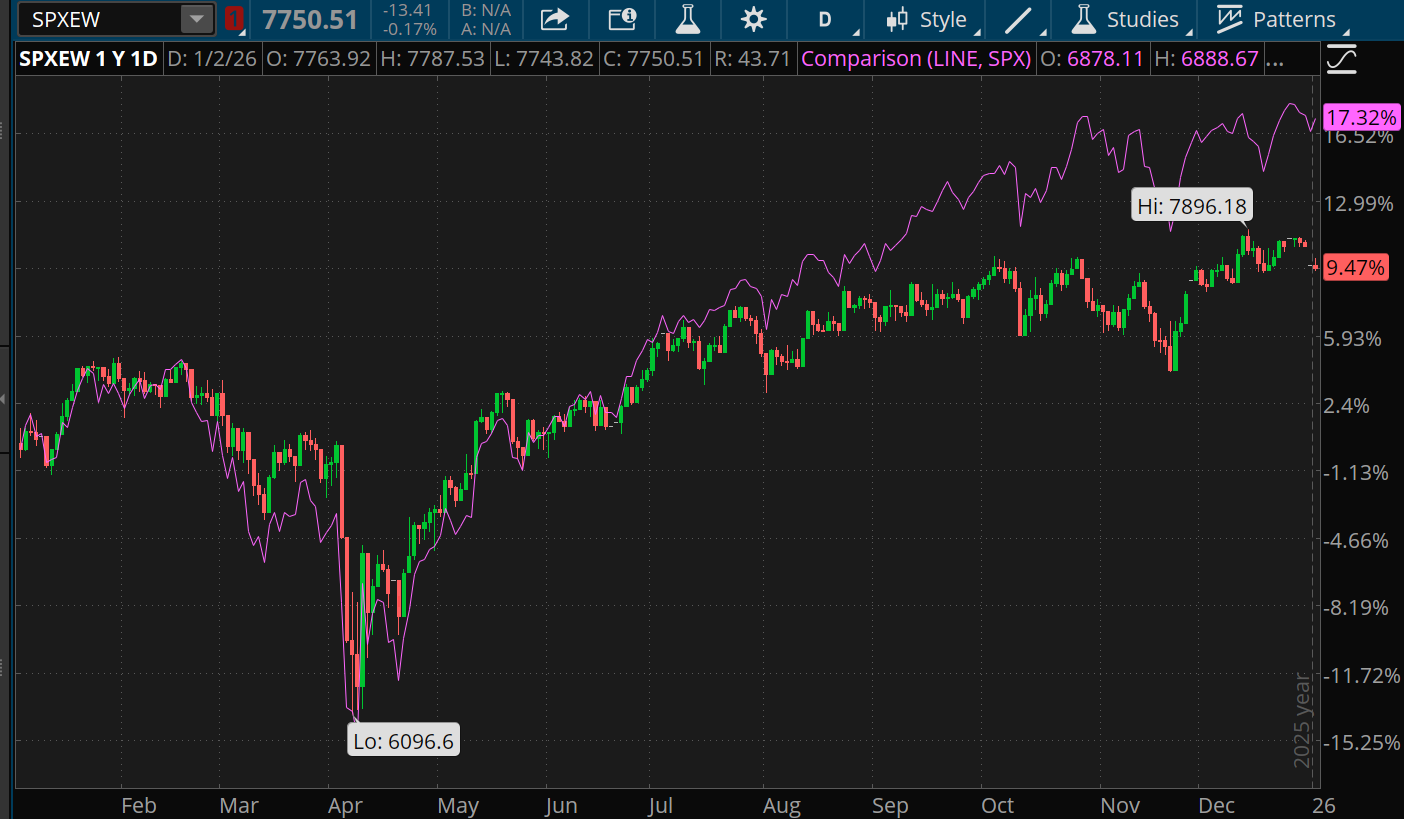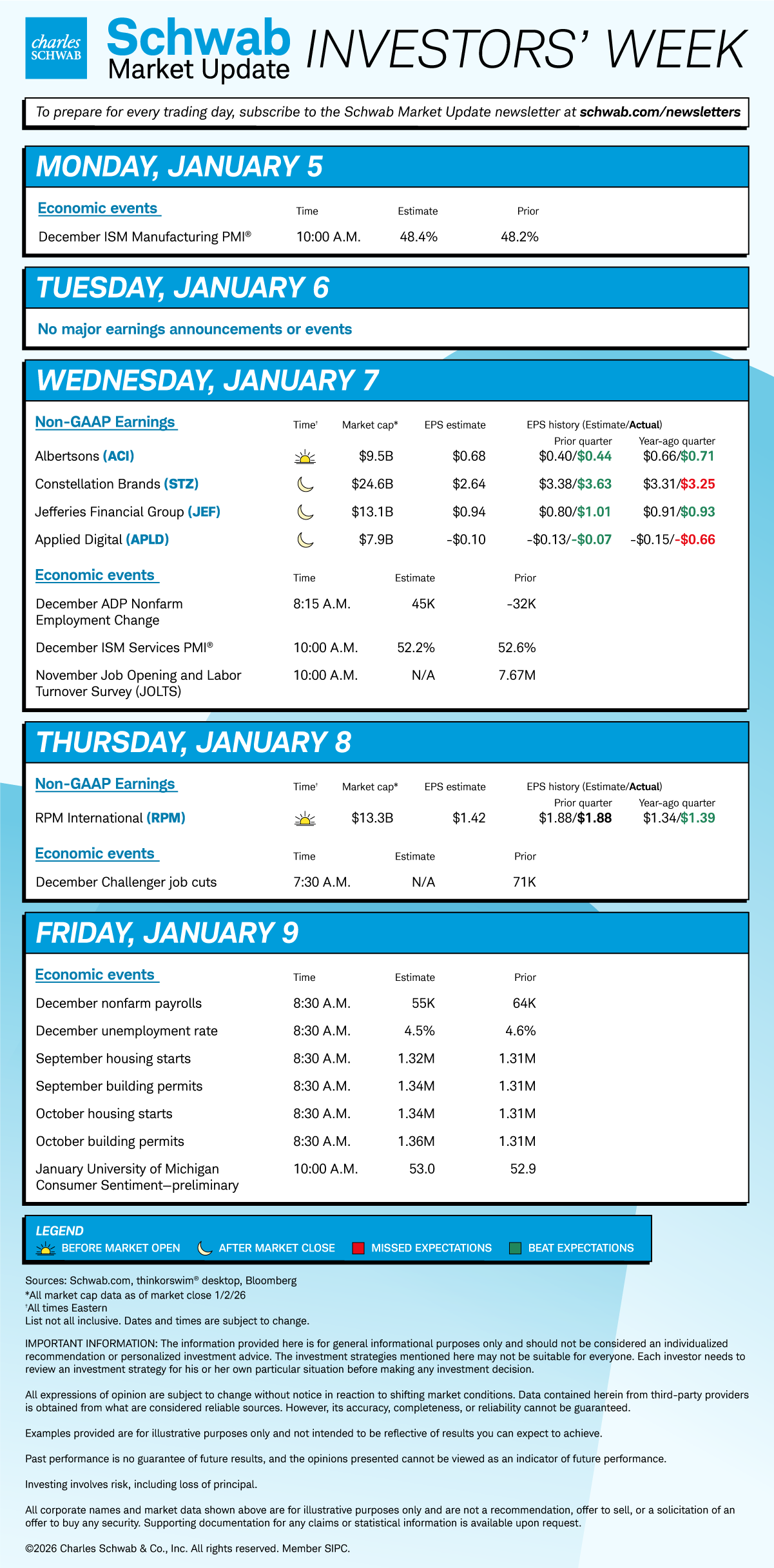Stocks Take Venezuela News in Stride, Rising Early

Published as of: January 5, 2026, 9:18 a.m. ET
Listen to this article
Listen here or subscribe for free to the Schwab Market Update in your favorite podcast app.
| The markets | Last price | Change | % change |
|---|---|---|---|
| S&P 500® index | 6,858.47 | +12.97 | +0.19% |
| Dow Jones Industrial Average® | 48,382.39 | +319.10 | +0.66% |
| Nasdaq Composite® | 23,235.63 | –6.36 | –0.03% |
| 10-year Treasury yield | 4.18% | -- | -- |
| U.S. Dollar Index | 98.84 |
+0.42 |
+0.43% |
| Cboe Volatility Index® | 15.14 | +0.63 | +4.34% |
| WTI Crude Oil | $57.87 | +$0.55 | +0.92% |
| Bitcoin | $93,045 | +2,855 |
+3.18% |
(Monday market open) Wall Street's initial response to weekend events in Venezuela was a collective shrug early Monday. Major indexes tracked mostly higher overnight and crude oil initially slipped before climbing but remains near recent one-year lows. The U.S. dollar rose and Treasury yields flattened.
Over the weekend, President Trump announced that Venezuelan President Nicolas Maduro was captured during a large-scale U.S. strike that began on January 2, and Maduro and his wife were transported to New York. Maduro faces drug trafficking and narco-terrorism charges, with Trump saying the United States would run the country--at least temporarily--and take control of Venezuela's oil reserves.
"The intervention of the U.S. into Venezuela is a more significant geopolitical event than a market event," Schwab experts said. "While the situation in Venezuela remains in flux and will undoubtedly continue to shift moving forward, global markets have thus far taken the news in stride. From here, much will depend on the degree of the U.S. involvement in Venezuela's future path, how larger oil producers outside of both countries will respond, and whether the energy market has a tantrum."
So far, there's no "tantrum" in sight, and the fundamental effect on crude oil could take a long time to play out. Venezuela has large reserves but isn't a big producer, accounting for about 1% of the world's daily oil output at less than one million barrels a day. That's down from three million several decades ago. Venezuela is an OPEC member, and the cartel agreed Sunday to keep current production levels, as analysts had expected before the attack on Venezuela.
Several major energy stocks were early beneficiaries of the news, with Chevron (CVX) up 6% Monday and ConocoPhillips (COP) up 5%. Chevron is the only large U.S. oil company that kept operations in Venezuela over the last decade.
All told, the weekend events aren't necessarily risk-free for investors. Markets might go into "risk-off" mode if the U.S. government considers similar actions against other regimes, and there's history to consider, too. The U.S. has struggled with regime change in the past, as seen with Iraq. However, Trump has criticized the 2003 Iraq invasion, giving investors hope that he'd avoid any sort of long-term U.S. effort to control Venezuela.
As trading continues today and markets absorb the news, remember that it's important not to overreact to geopolitical events—which are always part of investing and typically don't have a long-lasting impact on markets.
To get the Schwab Market Update in your inbox every morning, subscribe on Schwab.com.
Also in the news
Besides the geopolitical storm, investors entered the week focused on key jobs data after a relatively sluggish start to 2026 on Wall Street. Data kick off soon after the open with the ISM Manufacturing PMI for December. This report has been perpetually gloomy over the last year.
ISM and Wednesday's job openings data are simply appetizers to the main course, Friday's December nonfarm payrolls report. Analysts think around 55,000 jobs got created in December, about equal to November but low historically.
Minneapolis Federal Reserve President Neel Kashkari said on CNBC early today that current interest rates may be close to neutral, and that monetary policy "must not be putting that much downward pressure on the economy." He added there's a risk the unemployment rate could rise.
The S&P 500 index rose slightly on Friday to end a four-day skid but finished down 1% for the week after a negative December. The tech-heavy Nasdaq Composite fell Friday to extend its losing streak to five.
"Perhaps the pullback is related to year-end tax-loss selling, or the modest rise in longer-term Treasury yields, but it was a lackluster close-out to an otherwise impressive 16% gain in the S&P 500 for 2025," said Nathan Peterson, director of derivatives research and strategy, Schwab Center for Financial Research (SCFR).
Trading was light in recent days due to the holidays, so direction will be closely watched now that full participation has returned and market moves might be backed with firmer conviction.
Three things to watch
- Venezuela's potential impact on oil, interest rates: The oil futures complex could feature prices falling sharply in the "back months" (late-2026 and into 2027) on anticipation of lower prices due to increased supply, Schwab experts said. "Front months" (nearer term) likely won't be affected as much since it will take time, possibly years, for Venezuelan heavy crude to hit the market. Most of Venezuela's oil exports now go to China, accounting for about 5% of China's oil imports. Also, a drop in near-term prices could be limited by OPEC's decision to cut supplies until it can convene an emergency meeting. This uncertainty could also weigh on the direction of long-term Treasury yields which, in turn, could translate to equity market volatility. "We expect limited impact on the near-term decision-making by the Fed given the fluidity of the situation," Schwab's experts said. "However, if it looks like oil prices will trend lower and thus lead to lower gasoline prices, it would help ease the ongoing inflation problem and possibly set the stage for easier monetary policy. All else equal, this would be positive for the stock market."
- Chips, software go their separate ways: Friday's first trading day of 2026 resembled 2025 in at least one way, as semiconductor stocks outpaced software stocks. This trend harkens back to worries that AI might hurt demand for software tools. Chip stocks rose 4% as a sector Friday, led by some of the same familiar names that keyed last year's rally including memory chip makers Micron (MU) and Western Digital (WDC), whose products are now seen as integral for AI, which requires vast amounts of memory. For the latest outlook on chips, AI and related matters, investors likely want to monitor CES 2026, a global trade show this week focusing on robotics, AI, and wearables. The show features a press conference early this afternoon with Jensen Huang, CEO of Nvidia (NVDA). Another speaker to monitor is Lisa Su, CEO of Advanced Micro Devices (AMD), who delivers a keynote address this evening on her vision for future AI solutions.
- "Risk-on" returns, lifting crypto, metals: Silver futures (/SI), which fluctuated dramatically last week, are back on the upward path, rising 5% early today, and copper (/HG) soared 4%. Stocks associated with metals climbed early on, including Newmont (NEM) and Freeport McMoRan (FCX). Bitcoin (/BTC) jumped more than 3% this morning to back above $90,000 as risk sentiment appeared to improve. Stocks associated with crypto, including Coinbase (COIN) and Strategy (MSTR), added 4% ahead of the open. The climb in crypto and industrial metals could indicate that sentiment hasn't been dented by the weekend events in Venezuela. However, gold futures (/GC) also rose 2%, perhaps in part on geopolitical uncertainty. Other metals like palladium and platinum rose 5% this morning, and overall metals strength recently could reflect speculators looking for volatility in areas beyond crypto, which has sagged since October.
On the move
Chevron, which climbed sharply ahead of the open, may be best positioned among global oil giants to immediately benefit from U.S. access to Venezuelan oil, Bloomberg reported. A full revival of the country's oil industry could take many years and cost more than $100 billion, according to a public policy expert quoted by Bloomberg. Other oil stocks had their assets in Venezuela nationalized by the government, meaning they could potentially benefit if control changes in Caracas.
Tesla (TSLA) fell 2% Friday after reporting 418,227 vehicle deliveries in the fourth quarter. This was below analysts' consensus. Shares rose more than 1% today.
Ford (F) fell about 0.5% early Monday while General Motors (GM) dropped slightly less. Later today, investors receive monthly vehicle sales for December. Sales are seen at an annual rate of 16 million, but that likely fell to around 15.6 million in the final three months, down more than 5% from the third quarter, according to industry researcher Cox Automotive. A decline such as this could suggest a lack of momentum heading into the new year.
Comcast (CMCSA) fell nearly 6% ahead of the open and shares of its spinoff Versant Media (VSNT) fell more than 3%. The media companies finalized a split late Friday.
Chip and AI-related stocks generally rose early Monday, with shares of CoreWeave (CRWV), Marvell Technology (MRVL), Intel (INTC), and Western Digital leading, along with Micron. Palantir (PLTR) and Nvidia (NVDA) also rose, but breaking news appeared thin for the tech sector.
Defense firms Lockheed Martin (LMT) and Northrop Gruman (NOC) both rose a little more and a little less than 1%, respectively, early Monday following the action against Venezuela.
Treasury yields slipped early Monday, possibly due to hopes for lower crude oil prices that could factor into falling inflation. The 10-year yield then rose back to even before the open and remains near the high end of its recent range at 4.18%.
Software names came under pressure Friday on more worries about AI supplanting demand for their services. Shares of Adobe (ADBE) and Salesforce (CRM) fell 4% and 3%, respectively, though there wasn't any major sector-specific or company-specific news.
Caterpillar (CAT) rose more than 4.5% and Boeing (BA) also climbed 4% Friday amid strength in the industrial sector. Caterpillar is seen as a play on strength in mining since it's a supplier of mining equipment, Briefing.com pointed out. Boeing got a boost from news earlier last week that it had been awarded a $2.7 billion Army contract.
Futures trading prices in 18% odds of a January rate cut as of early today, according to the CME FedWatch Tool. That's up just slightly from late last week.
Though far more S&P 500 stocks rose than fell Friday, market breadth remains below last week's peak. About 57% of S&P 500 stocks traded above their 50-day moving averages as of late Friday, down from recent highs near 65%.
More insights from Schwab

Stock splits and options: When a stock splits, that can change options contracts. Learn how this works and how to prepare for it in Schwab's new options trading article.
Checking options stats on thinkorswim®: Learn how to track key options statistics like implied and historical volatility, the Sizzle Index™, and the put/call ratio on thinkorswim in our latest trading tools feature.
Chart of the day

Data source: S&P Dow Jones Indices. Chart source: thinkorswim® platform.
Past performance is no guarantee of future results.
For illustrative purposes only.
The S&P 500 Equal-Weight Index (SPXEW–candlestick), which weighs all S&P 500 stocks the same, rose 9.4% over the last year, trailing a 16% rise over that period for the S&P 500 index (SPX–purple line). This reinforces how strength from mega-caps helped the market-cap weighted S&P 500. It's also an indication that, for investors, checking the SPX may not give a full picture of market performance, as much of its gains came from just a handful of stocks.
The week ahead
